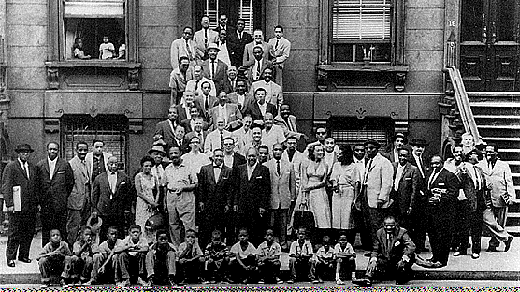
Chapter VIII is titled Dance, and could be seen as an overarching metaphor for the way you listen to JAZZ or RAG music. It is a full body experience, you must use all of your senses, feeling the vibrations, touching the lyrics, tasting the sweat on your lips, hearing the emotions, and seeing the passion of the performers. Hughes brings the reader right into the night club with Harriet on a steamy August night. What stands out to me is the way in which he does not rely on the reader’s knowledge of JAZZ or music in general. He eloquently wraps every last detail of sensation into this rhythmical chapter. His art is in delivering the experience through nothing but words, however, with an ability that carves through your senses like a sculptor carves through stone. I was sweating while reading this chapter, there was no music playing, but you could feel it, hear it, taste it, smell it, and most certainly see it through his keen observations. How could this be an author looking back? I would think that he must have been in a club while writing this vignette. I would have needed a DV camera to capture half as much as Hughes manages, not only to capture, but to deliver at a level that does not require prior knowledge of JAZZ. The JAZZ here is a fresh JAZZ, just off the train from New Orleans. Hughes writes, “A coalblack lad from New Orleans who had brought with him an exaggerated rag-time which he called jazz” (p. 105). He describes the music they are playing as capable of “playing the heart out of loneliness” which is the opposite of what the blues do for a listener. Well, I actually believe the blues brings company to your loneliness which is not quite the opposite. The music described includes excerpts of the lyrics like:
You gonna wake up some mawnin’
An’ turn yo’ smilin’ face.
Wake up some early mawnin’,
Says turn yo’ smiliin’ face,
Look at yo’ sweetie’s pillow—
An’ find an’ empty place! (p. 105)
The lyrics show the sadness being described, but it is like a roller coaster of emotions, ever so tightly tied to the musicians and the audience. The band members call out emotions and flare the tempo and pound the rhythm, beating into the audience and each other the heartbeat of life. He describes the instruments as such, “the piano was the water flowing, and the high, thin chords of the banjo were the mountains floating in the clouds. But in the sultry tones, alone and always, the brass cornet spoke harshly about he earth” (p. 96). Even the juxtaposition of instruments is a representation of the myriad of emotions depicted in JAZZ and experienced in life. JAZZ is a metaphor for life. I truly feel after reading this chapter that I have a deeper understanding of JAZZ music as a whole.






No comments:
Post a Comment